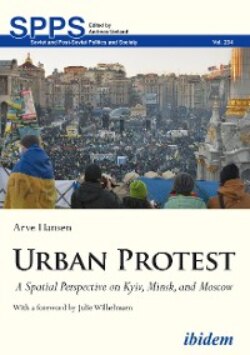Читать книгу Urban Protest - Arve Hansen - Страница 6
Foreword
ОглавлениеWhat impact does the physical space in which protesters raise their grievances have on their success or failure in achieving their goals? This is the intriguing question that Arve Hansen raises, and to which this book provides a theoretically, methodologically, and empirically sophisticated answer. It elaborates a theoretical model to explore the causal connections between urban public space and mass protests. As such, it is not only a valuable but also a major contribution to the growing research on mass protests and urban space.
This book also presents and analyses three of the most acute cases of urban protest today, namely those of Kyiv, Minsk, and Moscow. The combination of thematic focus and empirical case studies can, therefore, hardly be more timely. A wave of protest movements is rolling across what we refer to as the ‘former Soviet space’. Judging by recent events, it is not going to stop any time soon; even in Russia, where enormous and costly efforts have been made to create ‘stability’ under President Putin. The intense, at times highly simplistic public debate around these events makes this distinctly scholarly contribution particularly welcome. The book gives us details and specifics about the very different social and physical spaces of Kyiv, Minsk, and Moscow, despite their common Soviet heritage.
This analysis is built on the results of the author’s extensive field work: interviews as well as personal observations, all based in Hansen’s thorough knowledge of all three East Slavic languages and cultures and his experience of living in Belarus, Russia, and Ukraine. Careful attention is paid to the history and symbolic value of the urban spaces under analysis. The meticulous circuit of observing, noting, mapping, and interviewing is particularly commendable, resulting as it does in clear visual and textual presentations of the protest spaces in Kyiv, Minsk, and Moscow.
Hansen’s approach to the theoretical debate on protest, and the core terms within it, is also nuanced and attentive to detail. He crafts his definitions of mass protest and urban public space, as well as his theoretical model, using the cases at hand and in close consultation with the extant literature. The outcome is an excellent piece of academic handiwork. The process of developing the theoretical model over time, guided by empirical findings in the individual case studies, is presented clearly and well. Reading this book will prove highly instructive for students who wish to learn how to combine in-depth empirical work with theory development.
Examining the theoretical debate on protest, Hansen identifies a lack of attention in the literature to the connection between space and protest. Rightly pointing out the dangers of geographical determinism, he sets himself the ambitious aim of providing the systematic and generalised approach to space and protest that is missing. A comprehensive explanation of urban protest will have to include a wider set of social variables beyond those investigated in this book, which is clearly part of a broader, evolving research agenda under development. However, by the end of the book, Hansen has convincingly demonstrated the importance of geographical space and how it contributes to the emergence, realisation, and impact of protests. The spatial perspective also promises a fruitful application to cases beyond the former Soviet space.
Julie Wilhelmsen
Senior Research FellowNorwegian Institute of International Affairs
